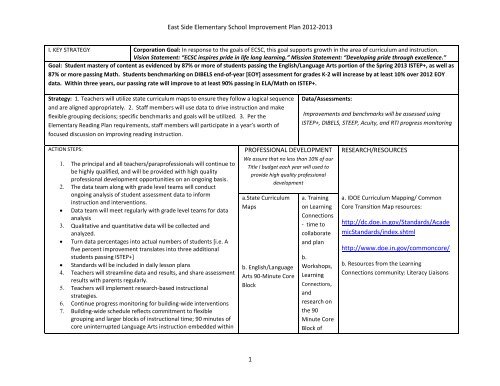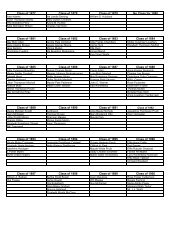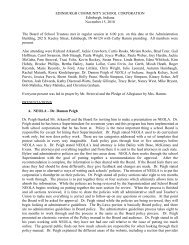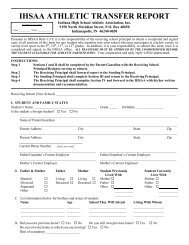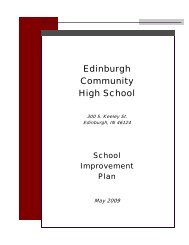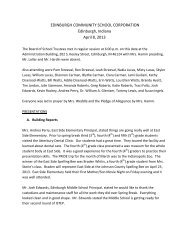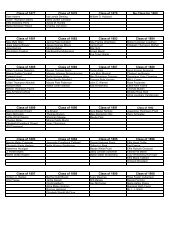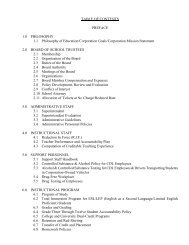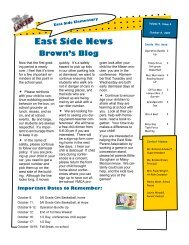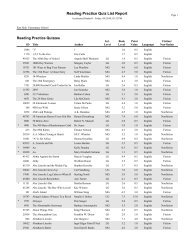East Side Elementary School's 2012 - 2013 ... - Edinburgh CSC
East Side Elementary School's 2012 - 2013 ... - Edinburgh CSC
East Side Elementary School's 2012 - 2013 ... - Edinburgh CSC
Create successful ePaper yourself
Turn your PDF publications into a flip-book with our unique Google optimized e-Paper software.
<strong>East</strong> <strong>Side</strong> <strong>Elementary</strong> School Improvement Plan <strong>2012</strong>-<strong>2013</strong><br />
I. KEY STRATEGY Corporation Goal: In response to the goals of E<strong>CSC</strong>, this goal supports growth in the area of curriculum and instruction.<br />
Vision Statement: “E<strong>CSC</strong> inspires pride in life long learning.” Mission Statement: “Developing pride through excellence.”<br />
Goal: Student mastery of content as evidenced by 87% or more of students passing the English/Language Arts portion of the Spring <strong>2013</strong> ISTEP+, as well as<br />
87% or more passing Math. Students benchmarking on DIBELS end-of-year [EOY] assessment for grades K-2 will increase by at least 10% over <strong>2012</strong> EOY<br />
data. Within three years, our passing rate will improve to at least 90% passing in ELA/Math on ISTEP+.<br />
Strategy: 1. Teachers will utilize state curriculum maps to ensure they follow a logical sequence<br />
and are aligned appropriately. 2. Staff members will use data to drive instruction and make<br />
flexible grouping decisions; specific benchmarks and goals will be utilized. 3. Per the<br />
<strong>Elementary</strong> Reading Plan requirements, staff members will participate in a year’s worth of<br />
focused discussion on improving reading instruction.<br />
ACTION STEPS:<br />
1. The principal and all teachers/paraprofessionals will continue to<br />
be highly qualified, and will be provided with high quality<br />
professional development opportunities on an ongoing basis.<br />
2. The data team along with grade level teams will conduct<br />
ongoing analysis of student assessment data to inform<br />
instruction and interventions.<br />
Data team will meet regularly with grade level teams for data<br />
analysis<br />
3. Qualitative and quantitative data will be collected and<br />
analyzed.<br />
Turn data percentages into actual numbers of students [i.e. A<br />
five percent improvement translates into three additional<br />
students passing ISTEP+]<br />
Standards will be included in daily lesson plans<br />
4. Teachers will streamline data and results, and share assessment<br />
results with parents regularly.<br />
5. Teachers will implement research-based instructional<br />
strategies.<br />
6. Continue progress monitoring for building-wide interventions<br />
7. Building-wide schedule reflects commitment to flexible<br />
grouping and larger blocks of instructional time; 90 minutes of<br />
core uninterrupted Language Arts instruction embedded within<br />
1<br />
Data/Assessments:<br />
PROFESSIONAL DEVELOPMENT<br />
We assure that no less than 10% of our<br />
Title I budget each year will used to<br />
provide high quality professional<br />
development<br />
a.State Curriculum<br />
Maps<br />
b. English/Language<br />
Arts 90-Minute Core<br />
Block<br />
Improvements and benchmarks will be assessed using<br />
ISTEP+, DIBELS, STEEP, Acuity, and RTI progress monitoring<br />
a. Training<br />
on Learning<br />
Connections<br />
- time to<br />
collaborate<br />
and plan<br />
b.<br />
Workshops,<br />
Learning<br />
Connections,<br />
and<br />
research on<br />
the 90<br />
Minute Core<br />
Block of<br />
RESEARCH/RESOURCES<br />
a. IDOE Curriculum Mapping/ Common<br />
Core Transition Map resources:<br />
http://dc.doe.in.gov/Standards/Acade<br />
micStandards/index.shtml<br />
http://www.doe.in.gov/commoncore/<br />
b. Resources from the Learning<br />
Connections community: Literacy Liaisons
a larger literacy block, and 60 minutes of core uninterrupted<br />
Math instruction daily<br />
8. Coordination and integration of available technology to<br />
enhance student learning- Compass, Airliners, Smart Boards,<br />
iPads, etc.<br />
9. In an effort to continue recruiting and retaining high quality<br />
teachers, we will increase teacher mentoring, training, and<br />
support opportunities<br />
release time for classroom visits<br />
training opportunities with interventionist<br />
recruitment at college job fairs by administration<br />
plan second staff retreat for summer <strong>2013</strong> as appropriately<br />
funded<br />
------------------------------------------------------------------------------------------------<br />
Current data:<br />
2011-<strong>2012</strong> EOY benchmark %:<br />
DIBELS NEXT<br />
Kdg: 76% ,1 st : 53%,2 nd : 58% (average 63%)<br />
DIBELS MATH<br />
Kdg:60%, 1 st :54%, 2 nd : 39% (average 51%)<br />
2011-<strong>2012</strong> ISTEP+ passing %:<br />
Math: 87.4%<br />
ELA: 88.5%<br />
<strong>East</strong> <strong>Side</strong> <strong>Elementary</strong> School Improvement Plan <strong>2012</strong>-<strong>2013</strong><br />
c. Technology inservices:<br />
Tech<br />
Tuesdays<br />
PERSON(S) RESPONSIBLE:<br />
2<br />
Instruction<br />
for ELA.<br />
Every other<br />
monthly<br />
staff<br />
meeting will<br />
be focused<br />
on Reading<br />
Instruction<br />
c. bi-weekly<br />
after school<br />
on Tuesdays<br />
for any<br />
interested<br />
staff<br />
member<br />
c. The technology coordinator or assistant<br />
will be available to provide inservices/refresher<br />
courses on available<br />
technologies<br />
All grade level/specials’ area teachers will utilize state curriculum maps.<br />
LEADERS: Principal, Curriculum Coordinator, Leadership Team, Grade Level<br />
and Committee Chairpersons
<strong>East</strong> <strong>Side</strong> <strong>Elementary</strong> School Improvement Plan <strong>2012</strong>-<strong>2013</strong><br />
II. LOW ACHIEVERS Corporation Goal: In response to the goals of E<strong>CSC</strong>, this goal supports growth in the areas of pride and curriculum and<br />
instruction.<br />
Vision Statement: “E<strong>CSC</strong> inspires pride in life long learning.” Mission Statement: “Developing pride through excellence.”<br />
Goal: Over the course of the next three years, the achievement gap between Special Education and General Education students, as well as the gap<br />
between Free and Reduced students and paid lunch students, will continue to decrease.<br />
Strategy: 1. Increase motivation for students to improve academic performance, discipline,<br />
and attendance. 2. Through regular data analysis, effective differentiated instruction, and<br />
appropriate interventions, the low achieving students will progress academically to perform<br />
on-grade level.<br />
ACTION STEPS:<br />
1. Special Education and Free & Reduced are the two subgroups<br />
where we see achievement gaps in comparison to the general<br />
population.<br />
For grades 3-5, 20-25% of the student population is<br />
identified special education. This includes students<br />
receiving speech and language services.<br />
67.9% of student population, Free & Reduced [F&R]<br />
On the Spring <strong>2012</strong> ISTEP+, overall passing percentage<br />
for Special Education ELA was 60% (compared to<br />
88.5% overall passing rate) and 79% in Math<br />
(compared to 87.4% overall passing rate). Overall<br />
passing percentage for F&R in ELA was 79% (compared<br />
to 88.5% overall passing rate) and 83% in Math<br />
(compared to 87.4% overall passing rate). This<br />
translates to an achievement gap for special education<br />
students of 28.5% in ELA and 8.4% in Math. The<br />
achievement gap for F&R was 9.5% in ELA and 4.4% in<br />
Math.<br />
Although 67.9% of our students qualify for F&R lunch<br />
status, the percentage of frequent tardies (4+) for F&R<br />
is 82% of all frequent tardies.<br />
Of the 75 students with discipline referrals resulting in<br />
a consequence from office in 2011-<strong>2012</strong>, 85% were<br />
F&R students (64), 26% were special education (20),<br />
PROFESSIONAL DEVELOPMENT<br />
We assure that no less than 10% of our<br />
Title I budget each year will used to<br />
provide high quality professional<br />
development<br />
a. Title I Camp and<br />
Interventionist<br />
b. Book Clubdifferentiated<br />
by<br />
teacher choice/<br />
need (based on a<br />
list of book choices)<br />
3<br />
Data/Assessments: formative and summative data: ISTEP+,<br />
SDS discipline and attendance data, DIBLES, STEEP, RTI<br />
progress monitoring data<br />
a. work with<br />
individual<br />
teachers to<br />
help best<br />
meet their<br />
students<br />
needs<br />
b. bimonthly<br />
staff<br />
meetings<br />
RESEARCH/RESOURCES/RATIONALE<br />
a.http://www.lindamoodbell.com/<br />
http://www.smekenseducation.com/<br />
b. book titles below:<br />
A Framework for Understanding Poverty by<br />
Ruby K. Payne<br />
http://www.amazon.com/Framework-<br />
Understanding-Poverty-Ruby-<br />
Payne/dp/1929229488<br />
Classroom Instruction that Works by Robert<br />
J. Marzano, Debra J. Pickering, and Jane E.<br />
Pollock<br />
http://www.amazon.com/Classroom-<br />
Instruction-That-Works-Research-<br />
Based/dp/0871205041<br />
Dealing With Difficult Parents (and With<br />
Parents in Difficult Situations) by Todd<br />
Whitaker and Douglas J. Fiore
and 25% were both F&R and special education (19).<br />
2. Our low-achieving students need motivation to achieve up to<br />
their potential.<br />
We will continue our college readiness focus using the No<br />
Excuses University model<br />
We will implement new building-wide<br />
incentives/motivators for students and families to improve<br />
academics, attendance, and discipline<br />
The global connect phone system, school website, and<br />
Twitter will be used as a motivational communication tools<br />
between school and home<br />
3. Math: ISTEP scores were overall above state cut scores, areas<br />
to focus continued improvement include Problem Solving,<br />
Algebra Functions and Computation. In grades K-5 the overall<br />
percentage of students reaching the End-of-Year [EOY]<br />
benchmarks for DIBELS MATH (K-2) and STEEP MATH (3-5)<br />
computational fluency was 44% in 2011-<strong>2012</strong>. K: 60%, 1 st<br />
grade: 54%, 2 nd : 39%, 3 rd : 29%, 4 th : 42%, 5 th : 42%. 42% of<br />
kindergarteners reached the EOY benchmark for Number<br />
Naming.<br />
There will be a daily focus and opportunities for practice in<br />
timed facts and computation at all grade levels<br />
Formative assessments will be developed and utilized to collect<br />
evidence of daily/weekly progress and make data driven<br />
instructional decisions<br />
Research based instructional strategies from previous<br />
Professional development, i.e. differentiation, classroom<br />
instruction that works, etc. will be revisited and incorporated<br />
into instruction<br />
2. ELA: ISTEP scores were overall above state cut scores, areas<br />
to focus continued improvement are Language Conventions,<br />
<strong>East</strong> <strong>Side</strong> <strong>Elementary</strong> School Improvement Plan <strong>2012</strong>-<strong>2013</strong><br />
c. formative vs.<br />
summative<br />
assessments<br />
d. Best practices<br />
training sessions for<br />
Instructional Aides<br />
e. Revisit, seek, and<br />
utilize researchbased<br />
instruction<br />
and interventions in<br />
daily instruction<br />
4<br />
c. ongoing<br />
d. ongoing<br />
as needed<br />
e. ongoing<br />
http://books.google.com/books/about/<br />
Dealing_with_Difficult_Parents.html?id<br />
=eC4pMCINb8sC<br />
Teach Like a Champion: 49 Techniques That<br />
Put Students on the Path to College by Doug<br />
Lemov<br />
http://www.josseybass.com/WileyCDA/Wil<br />
eyTitle/productCd-0470550473.html<br />
Teach Like a Techie by Lori Elliott<br />
http://www.crystalspringsbooks.com/techn<br />
ology/teach-like-a-techie:-20-tools-forreaching-the-digitalgeneration/Page_1/550209.html<br />
c. Formative and Summative Assessments<br />
in the classroom:<br />
http://www.nmsa.org/Publications/WebEx<br />
clusive/Assessment/tabid/1120/Default.asp<br />
x<br />
Curriculum Frameworks- activities, pre and<br />
post assessments, etc.<br />
http://dc.doe.in.gov/Standards/AcademicSt<br />
andards/index.shtml<br />
d. We will provide opportunities for IA<br />
professional development to help them<br />
best support school improvement goals.<br />
e. The What Works Clearinghouse<br />
http://www.w-w-c.org/ established by the<br />
U.S. Department of Education’s
Vocabulary, Writing process and Writing Applications.<br />
ELA: K-2 DIBELS scores show 53-76% (62.33% avg) and 3-5<br />
STEEP Oral Reading Fluency scores show 68-82% (73.33% avg) of our<br />
students met EOY benchmark goals in early literacy skills, thus we have<br />
an additional focus on continuing improvement of Oral Reading Fluency<br />
Skills.<br />
Our 12-13 staff book club will be differentiated by teacher<br />
choice focused on integrating technology, engaging students, or<br />
improving reading/vocabulary instruction<br />
Daily authentic opportunities for Language Conventions<br />
practice will be provided at all grade levels<br />
Accelerated Reader will continue as a motivational tool and<br />
support for reading comprehension.<br />
Formative assessments will be developed and utilized to collect<br />
evidence of daily/weekly progress and make data driven<br />
instructional decisions<br />
Revisit research based instructional strategies from previous<br />
Professional development, i.e. differentiation, classroom<br />
instruction that works, etc. and incorporate into instruction<br />
Supports to strengthen core academic subjects for all low-achievers,<br />
1. Flexible student grouping will be utilized to provide<br />
differentiated instruction within the classroom and for class<br />
placement<br />
2. Along with the general education teacher, Title I teachers,<br />
Special Education teachers, and/or support staff will be used to<br />
lower the student-to-teacher ratio in classrooms with low<br />
achieving students to better provide individualized instruction<br />
3. General Education Intervention meetings (GEI) will be held to<br />
continue to analyze student information and problem-solve<br />
strategies to meet student needs<br />
4. RtI (Response to Instruction), a three-tiered model of student<br />
instructional support, will continue to serve as the framework<br />
<strong>East</strong> <strong>Side</strong> <strong>Elementary</strong> School Improvement Plan <strong>2012</strong>-<strong>2013</strong><br />
PERSON(S) RESPONSIBLE:<br />
5<br />
Institute of Education Sciences to provide<br />
educators, policymakers, and the public<br />
with a central,<br />
independent, and trusted source of<br />
scientific evidence of what works in<br />
education.<br />
Classroom Instruction that Works. Robert<br />
Marzano.<br />
Learning Connections resources<br />
All staff members will maintain a focus and commitment to motivating our<br />
students.<br />
All grade level teachers are responsible for incorporating computation and<br />
authentic language conventions practice into daily lesson plans, and using<br />
formative and summative assessments to make instructional decisions on<br />
a weekly basis.<br />
All instructional aides will support school improvement goals as well.<br />
LEADERS: Principal, Counselor, Grade Level Chairpersons, CAMP<br />
commander
for support at <strong>East</strong> <strong>Side</strong>.<br />
5. Students will participate in DIBELS, Acuity, and/or STEEP<br />
assessments three times a year following as follows:<br />
1. All K - 2 students will participate in DIBELS Next<br />
assessment three times per year.<br />
2. All 3 - 5 students will participate in STEEP Math<br />
assessments three times per year.<br />
3. All 3 - 5 students will participate in STEEP Maze<br />
assessments three times per year.<br />
4. All 3 - 5 students will participate in STEEP Oral Reading<br />
Fluency assessments three times per year.<br />
5. All 3-5 students will participate in Acuity Predictive<br />
assessments three times a year.<br />
6. The Data Team will meet regularly with general education<br />
teachers to share DIBELS and STEEP assessment results and<br />
progress monitoring data and discuss how that information can<br />
drive instruction. Acuity data and planning will also be<br />
discussed.<br />
7. Scientific research-based computer interventions such as<br />
Earobics, Reading Center, Headsprout Early Reading,<br />
Headsprout Reading Comprehension, Read Naturally,<br />
ReadAbout, and FASTT Math will continue to be used with nonidentified<br />
students whose scores fall in the strategic range.<br />
8. Our CAMP (Creative Activities Multi-Intelligence Place) teacher<br />
and Interventionist will provide intensive small group<br />
instruction with students needing intervention four days a<br />
week, and they will provide focused enrichment for high ability<br />
students one day per week.<br />
<strong>East</strong> <strong>Side</strong> <strong>Elementary</strong> School Improvement Plan <strong>2012</strong>-<strong>2013</strong><br />
6
<strong>East</strong> <strong>Side</strong> <strong>Elementary</strong> School Improvement Plan <strong>2012</strong>-<strong>2013</strong><br />
III. HIGH ABILITY STUDENTS Corporation Goal: In response to the goals of E<strong>CSC</strong>, this goal supports growth in the area of curriculum and instruction.<br />
Vision Statement: “E<strong>CSC</strong> inspires pride in life long learning.” Mission Statement: “Developing pride through excellence.”<br />
Goal: The percentage of students earning a “Pass Plus” on ISTEP+ will continue to increase.<br />
Strategy: Through increased identification, regular data analysis, effective differentiated<br />
instruction, and appropriate enrichment opportunities, the high achieving students will<br />
continue to show advanced academic growth above and beyond their current level of<br />
achievement.<br />
ACTION STEPS:<br />
1. Math: 3 rd grade: 29% Pass+ in <strong>2012</strong> compared to 53% in 2011<br />
4 th grade: 24% Pass+ in <strong>2012</strong> compared to 15% in 2011<br />
5 th grade: 22% Pass+ in <strong>2012</strong> compared to 22 % in 2011<br />
2. ELA: 3 rd grade: 9% Pass+ in <strong>2012</strong> compared to 20% in 2011<br />
4 th grade: 20% Pass+ in <strong>2012</strong> compared to 13% in 2011<br />
5 th grade: 14% Pass+ in <strong>2012</strong> compared to 11% in 2011<br />
3. Identification #’s in 2011-<strong>2012</strong>:<br />
3 rd : HA G: 4, HA M: 14, HA L: 2<br />
4 th : HA G: 13, HA M: 12, HA L: 2<br />
5 th : HA G: 6, HA M: 7, HA L: 6<br />
4. Use student profile to determine students with high<br />
achievement, and/or high ability/ potential for high ability<br />
5. Provide parent recommendation opportunities for<br />
identification purposes<br />
6. Provide differentiated instruction within the High Ability<br />
classroom by a licensed GT/HA teacher<br />
7. Use the KOI to identify specific areas of giftedness<br />
8. Implement Guidance Counseling Plan for High Ability students<br />
to meet their specific social and emotional needs<br />
9. Regular district-wide High Ability Broad-based Planning<br />
Committee meetings<br />
10. Continue exploring opportunities for increased enrichment<br />
opportunities outside of the classroom i.e. mentoring program,<br />
after-school or summer enrichment program<br />
11. CAMP utilized one day each week for additional extension or<br />
enrichment for high ability classes<br />
7<br />
Data/Assessments: ISTEP+, graded assignments<br />
Improvements and benchmarks will be assessed using,<br />
DIBLES, STEEP, KOI, CoGat<br />
PROFESSIONAL DEVELOPMENT RESEARCH/RESOURCES<br />
a. Indiana<br />
Association for the<br />
Gifted [IAG]<br />
PERSON(S) RESPONSIBLE:<br />
a. annual<br />
conference<br />
often<br />
attended by<br />
HA teachers<br />
a. Indiana Association for the Gifted:<br />
http://www.iagonline.org/Indiana_Association_for_the_Gi<br />
fted/IAG_Home.html<br />
a. Indiana Dept. of Education- High Ability:<br />
http://www.doe.in.gov/exceptional/gt/wel<br />
come.html<br />
LEADERS: High Ability Teachers, High Ability Coordinator, Counselor
IV. FAMILY AND COMMUNITY<br />
INVOLVEMENT<br />
<strong>East</strong> <strong>Side</strong> <strong>Elementary</strong> School Improvement Plan <strong>2012</strong>-<strong>2013</strong><br />
Corporation Goal: In response to the goals of E<strong>CSC</strong>, this goal supports growth in the areas of pride and curriculum and<br />
instruction.<br />
Vision Statement: “E<strong>CSC</strong> inspires pride in life long learning.” Mission Statement: “Developing pride through excellence.”<br />
Goal: Student mastery of content as evidenced by 87% or more of students passing the English/Language Arts portion of the Spring <strong>2013</strong> ISTEP+, as well as<br />
87% or more passing Math. Students benchmarking on DIBELS end-of-year [EOY] assessment for grades K-2 will increase by at least 10% over <strong>2012</strong> EOY<br />
data. Within three years, our passing rate will improve to at least 90% passing in ELA/Math on ISTEP+.<br />
Strategy: 1. Continue working to improve communication regarding academic progress and<br />
needs with parents. 2. Increase effective parental involvement in the school through a<br />
variety of means<br />
ACTION STEPS:<br />
1. During the Open House, parents will be encouraged to commit<br />
time/effort to at least one school event during the school year through signup<br />
lists for each opportunity<br />
Utilize as an opportunity to share classroom expectations,<br />
procedures, proficiency levels students are expected to meet, goalsetting,<br />
character traits, Take 5, etc.<br />
At Parent/Teacher conferences, Title I school-parent compact will<br />
be shared<br />
2. Regularly update the school website and communicate via Twitter. All<br />
teachers will be encouraged to have a classroom website that parents and<br />
students can navigate to find helpful information and links that supports<br />
student learning, up-to-date classroom information, etc.<br />
Share pertinent overall school academic information and school<br />
improvement goals<br />
Build positive rapport<br />
Include upcoming opportunities for families to be involved at<br />
school<br />
Include tips and strategies to help parents assist their child’s<br />
learning at home<br />
Inform parents of community resources<br />
Celebrate the achievements of our students<br />
3. Maintain and inform parents of parent resource materials, including<br />
training on Parent Connect<br />
8<br />
Data/Assessments: documentation of letters mailed/sent<br />
home, meetings held [attendance logs]<br />
PROFESSIONAL DEVELOPMENT RESEARCH/RESOURCES<br />
a. parent<br />
involvement<br />
discussions<br />
wrapped into<br />
Leadership Team<br />
meetings<br />
b. parent<br />
involvement<br />
coordinator will<br />
incorporate best<br />
practice in parent<br />
involvement to<br />
increase parent<br />
involvement<br />
a. monthly<br />
b. ongoing<br />
b. School-Parent-Community Partnership<br />
Resource Book, Indiana Dept. of Education:<br />
http://www.doe.in.gov/publications/pdf_ot<br />
her/SFCPnarrative.pdf<br />
The Indiana Partnerships Center<br />
http://www.fscp.org/<br />
U.S. Dept. of Education, parent resources:<br />
http://www.ed.gov/parents/landing.jhtml
4. Teachers will communicate regularly with parents to share qualitative and<br />
quantitative data, especially pertinent school-wide assessments and discuss<br />
the overall academic achievement of the child. When appropriate to a<br />
child’s needs, interventions will be explained.<br />
5. Maintain regular school-home communication via the student agenda in<br />
grades 3-5, and weekly folders in grades K-2<br />
6. Communication through email, voicemail, and the school website for<br />
parents will be continued and the use of technology for communication will<br />
increase.<br />
7. Commitment to overall positive communication/relationship building with<br />
parents/guardians<br />
8. Communicate with ELL families through translated communication from<br />
school on a regular basis, and have interpreters available for conferences<br />
9. Elicit and make use of parent volunteers by collaborating with community<br />
members<br />
10. Collaborate with <strong>Edinburgh</strong> Wright-Hageman Library, Camp Atterbury,<br />
and other community resources<br />
11. Continue monthly Family Nights aligned with the IN Academic Standards<br />
12.Provide parents with the opportunity to participate in the planning,<br />
reviewing, and improvement of the School Improvement Plan and Title I<br />
program<br />
Parent information meeting<br />
Link to our School improvement plan posted on <strong>East</strong> <strong>Side</strong>’s website<br />
Encourage comments and conversations regarding school-wide<br />
plan<br />
13. Parent coordinator will help create/host regular informational<br />
meetings/sessions in addition to Family Night to help parents learn effective<br />
ways to support their child’s learning; can be linked to No Excuses University<br />
preparation as well. Flexible meeting schedule will be offered<br />
<strong>East</strong> <strong>Side</strong> <strong>Elementary</strong> School Improvement Plan <strong>2012</strong>-<strong>2013</strong><br />
PERSON(S) RESPONSIBLE:<br />
All teachers are responsible for maximizing parent involvement and<br />
communication for all students within his/her classroom<br />
LEADERS: Parent Involvement Coordinator, Principal, Counselor<br />
9
V. TRANSITIONS AND<br />
COLLABORATION<br />
<strong>East</strong> <strong>Side</strong> <strong>Elementary</strong> School Improvement Plan <strong>2012</strong>-<strong>2013</strong><br />
Corporation Goal: In response to the goals of E<strong>CSC</strong>, this goal supports growth in the area of curriculum and instruction.<br />
Vision Statement: “E<strong>CSC</strong> inspires pride in life long learning.” Mission Statement: “Developing pride through excellence.”<br />
Goal: Student mastery of content as evidenced by 87% or more of students passing the English/Language Arts portion of the Spring <strong>2013</strong> ISTEP+, as well as<br />
87% or more passing Math. Students benchmarking on DIBELS end-of-year [EOY] assessment for grades K-2 will increase by at least 10% over <strong>2012</strong> EOY<br />
data. Within three years, our passing rate will improve to at least 90% passing in ELA/Math on ISTEP+.<br />
Strategy: Plan collaboration and improve communication between grade levels and pivotal<br />
transitions to better meet students’ academic and developmental needs.<br />
ACTION STEPS:<br />
1. Kindergarten teachers will meet in Spring with the special education<br />
pre-school teacher regarding readiness skills and kindergarten<br />
expectations, to discuss and plan for incoming students.<br />
2. The Johnson County Learning Center pre-school and Special Education<br />
pre-school students entering Kindergarten will be invited to visit <strong>East</strong><br />
<strong>Side</strong> <strong>Elementary</strong> in the spring in preparation for entering Kindergarten.<br />
3. Kindergarten teachers will meet with pre-school teachers in October<br />
and April to collaborate regarding readiness skills and kindergarten<br />
expectations.<br />
4. Fifth and sixth grade teachers will meet to discuss transition strategies<br />
to align curriculum, instruction, expectations and the continuation of our<br />
goals and strategies at least once a year via email, interoffice mail,<br />
conference, or phone conference.<br />
5. Cross grade-level meetings bimonthly to plan transition strategies to<br />
support all students, and discuss gaps and expectations.<br />
10<br />
Data/Assessments: documentation of meetings<br />
PROFESSIONAL DEVELOPMENT RESEARCH/RESOURCES<br />
a. transition<br />
resources<br />
a. share as<br />
needed<br />
a. Indiana Department of Education,<br />
Division of Early Learning and Literacy:<br />
http://www.doe.in.gov/primetime/<br />
b. The Transition to Middle School. Donna<br />
Schumacher:<br />
http://www.ericdigests.org/1999-<br />
2/middle.htm
6. Students participate in 5 th Grade Academy transitional program<br />
7. Transition conferences will be held for all fifth grade special<br />
education students to plan for middle school changes<br />
8. We do not financially consolidate, but we coordinate and integrate<br />
federal, state, and local funding such as: Title I grant, Full Day<br />
Kindergarten grant, High Ability grant, Special Education funding, etc.<br />
<strong>East</strong> <strong>Side</strong> <strong>Elementary</strong> School Improvement Plan <strong>2012</strong>-<strong>2013</strong><br />
PERSON(S) RESPONSIBLE:<br />
LEADERS: Principal, Kindergarten teachers, Pre-School teacher, 5 th grade<br />
teachers, Counselor<br />
11


